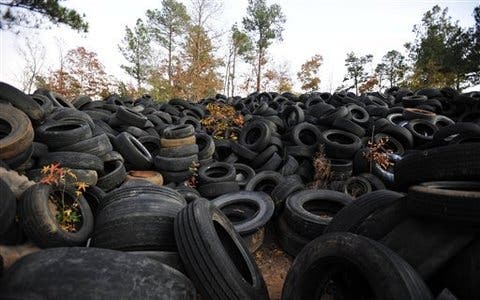
Just one of the slew of dumped tires, as seen in a wooded area near Elloree, S.C. on Nov. 17, 2011. Officials say a $400 littering fine is hardly enough to deal with the problem. (AP Photo/Rainier Ehrhardt)
Authorities have come across a giant mound of 250,000 scrap tires in rural South Carolina, so spread out that it occupies 50 hectares and is visible from space. A transportation and recycling operation of the mound has began since then.
The rural clearing in which the tires were dumped is practically impossible to notice, since its only accessible by a circuitous dirt path that winds through thick patches of trees. Calhoun County Council Chairman David Summers, however, says of this giant rubber menace, “You can see it from space.’’
So far, the owner of the property has been charged and a Florida based company will handle the transporation and recycling. Between 10 and 15 tractor-trailer loads of tires have been shipped to the Florida facility, up until now. What are the measures against the owner, though? Well, state law dictates this is a case of littering, which entails a measly $475 fine.
If you think 250,000 heaped tires visible from space is whooping enough, for the locals this doesn’t seem to strike them too much of a surprise. The surroundings of Calhoun County and other rural areas have dwelt with other similar cases in the past, the most memorable of which was a giant tire pile in the 1990s that would dwarf the current monstrosity.
“This tire pile here is a baby compared to what that one was,” said Summers, who previously worked for a company that ended up shredding those used tires.
The South Carolina mound is expected to be fully transported and recycled by 2012, during which it will be turned into steel and oil, or they will be shredded and made into tire-derived fuel, which burns more cleanly than coal and is typically used by paper mills.









